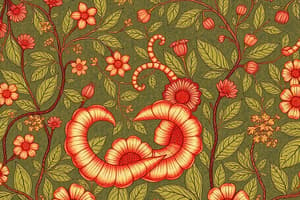Podcast
Questions and Answers
What is the role of malonyl-CoA in fatty acid metabolism?
What is the role of malonyl-CoA in fatty acid metabolism?
- Inhibits the transport of fatty acids into mitochondria (correct)
- Promotes the conversion of acetyl-CoA to ketone bodies
- Stimulates the breakdown of fatty acids in mitochondria
- Enhances gluconeogenesis in the liver
Which of the following statements is true regarding vitamin B12?
Which of the following statements is true regarding vitamin B12?
- It is synthesized by microbes. (correct)
- It is also known as hydroxocobalamin.
- It is used primarily for energy production.
- It is synthesized by plants and animals.
In which organ are ketone bodies predominantly formed?
In which organ are ketone bodies predominantly formed?
- Heart
- Kidneys
- Liver (correct)
- Lungs
What are the main types of ketone bodies produced from acetyl-CoA?
What are the main types of ketone bodies produced from acetyl-CoA?
What is the consequence of elevated levels of ketone bodies?
What is the consequence of elevated levels of ketone bodies?
What is produced at the end of normal β-oxidation of odd-number fatty acids?
What is produced at the end of normal β-oxidation of odd-number fatty acids?
Which enzyme is responsible for reducing the trans-2 cis-4 bond in cis-double bond intermediates?
Which enzyme is responsible for reducing the trans-2 cis-4 bond in cis-double bond intermediates?
Which coenzyme is essential for the isomerization step in the oxidation of odd-number fatty acids?
Which coenzyme is essential for the isomerization step in the oxidation of odd-number fatty acids?
What is the primary reason for reduced energy output in the oxidation of unsaturated fatty acids compared to saturated ones?
What is the primary reason for reduced energy output in the oxidation of unsaturated fatty acids compared to saturated ones?
What is the configuration of most naturally occurring unsaturated fatty acids?
What is the configuration of most naturally occurring unsaturated fatty acids?
What is the primary function of epinephrine in fatty acid metabolism?
What is the primary function of epinephrine in fatty acid metabolism?
What type of bond is typically formed between C-2 and C-3 in β-oxidation intermediates?
What type of bond is typically formed between C-2 and C-3 in β-oxidation intermediates?
Which of the following fatty acids cannot be oxidized in the mitochondria due to its structure?
Which of the following fatty acids cannot be oxidized in the mitochondria due to its structure?
What happens to the propionyl-CoA produced from odd-number fatty acids?
What happens to the propionyl-CoA produced from odd-number fatty acids?
What problem does the cis configuration present for β-oxidation of unsaturated fatty acids?
What problem does the cis configuration present for β-oxidation of unsaturated fatty acids?
What is the role of ketone bodies in metabolism?
What is the role of ketone bodies in metabolism?
Which enzyme is crucial for the activation of fatty acids before they can undergo beta-oxidation?
Which enzyme is crucial for the activation of fatty acids before they can undergo beta-oxidation?
Which blood component is directly linked to lipid transport and is often elevated in conditions like diabetes?
Which blood component is directly linked to lipid transport and is often elevated in conditions like diabetes?
What is the primary alternative fuel used by the body during starvation and untreated diabetes mellitus?
What is the primary alternative fuel used by the body during starvation and untreated diabetes mellitus?
How does the level of oxaloacetate (OAA) affect the conversion of acetyl-CoA in the liver?
How does the level of oxaloacetate (OAA) affect the conversion of acetyl-CoA in the liver?
What condition is caused by untreated diabetes mellitus that leads to an accumulation of ketone bodies?
What condition is caused by untreated diabetes mellitus that leads to an accumulation of ketone bodies?
What is the effect of glucagon on fatty acid metabolism in the state of untreated diabetes?
What is the effect of glucagon on fatty acid metabolism in the state of untreated diabetes?
What happens to the production of ketone bodies during prolonged starvation?
What happens to the production of ketone bodies during prolonged starvation?
Which enzyme's absence in the liver is crucial in the utilization of ketone bodies in peripheral tissues?
Which enzyme's absence in the liver is crucial in the utilization of ketone bodies in peripheral tissues?
Which of the following best describes the physiological relevance of chylomicrons?
Which of the following best describes the physiological relevance of chylomicrons?
What is the main reason behind the overproduction of ketone bodies during starvation?
What is the main reason behind the overproduction of ketone bodies during starvation?
What is the primary energy source for hibernating animals and migratory birds?
What is the primary energy source for hibernating animals and migratory birds?
What is the main component of chylomicrons?
What is the main component of chylomicrons?
What role does epinephrine play in fat mobilization from adipose tissue?
What role does epinephrine play in fat mobilization from adipose tissue?
What is a major consequence of conjugation of fatty acids with CoA in regard to energy metabolism?
What is a major consequence of conjugation of fatty acids with CoA in regard to energy metabolism?
What is the total ATP yield from the complete β-oxidation of palmitic acid (C16)?
What is the total ATP yield from the complete β-oxidation of palmitic acid (C16)?
Which of the following components are recognized by receptors on cell surfaces in lipoproteins?
Which of the following components are recognized by receptors on cell surfaces in lipoproteins?
Which of the following molecules serves as a shuttle for fatty acids into mitochondria?
Which of the following molecules serves as a shuttle for fatty acids into mitochondria?
What is the first stage of fatty acid oxidation in mitochondria?
What is the first stage of fatty acid oxidation in mitochondria?
Which type of fatty acids does β-oxidation primarily work with?
Which type of fatty acids does β-oxidation primarily work with?
How is the conjugation of fatty acids to CoA energetically characterized?
How is the conjugation of fatty acids to CoA energetically characterized?
Which of the following statements about the metabolism of glycerol is correct?
Which of the following statements about the metabolism of glycerol is correct?
What is the role of PKA during fat mobilization in adipose tissue?
What is the role of PKA during fat mobilization in adipose tissue?
What is the end result of transferring electrons from FADH2 and NADH during fatty acid oxidation?
What is the end result of transferring electrons from FADH2 and NADH during fatty acid oxidation?
Which lipid class is not part of the chylomicron composition?
Which lipid class is not part of the chylomicron composition?
Flashcards
Fatty Acid Catabolism
Fatty Acid Catabolism
The breakdown of fatty acids for energy production.
Fatty Acids
Fatty Acids
Long-chain hydrocarbon molecules that serve as a primary energy source.
Triacylglycerols
Triacylglycerols
Stored fat in adipose tissue, broken down into fatty acids for energy.
Epinephrine
Epinephrine
Signup and view all the flashcards
β-oxidation
β-oxidation
Signup and view all the flashcards
Acetyl-CoA
Acetyl-CoA
Signup and view all the flashcards
Carnitine
Carnitine
Signup and view all the flashcards
Chylomicrons
Chylomicrons
Signup and view all the flashcards
Glycerol
Glycerol
Signup and view all the flashcards
Mitochondria
Mitochondria
Signup and view all the flashcards
Glycolytic Pathway
Glycolytic Pathway
Signup and view all the flashcards
Citric Acid Cycle
Citric Acid Cycle
Signup and view all the flashcards
Fatty Acid Activation
Fatty Acid Activation
Signup and view all the flashcards
Energy Yield
Energy Yield
Signup and view all the flashcards
Adipocytes
Adipocytes
Signup and view all the flashcards
Succinyl-CoA synthesis from methylmalonyl-CoA mutase
Succinyl-CoA synthesis from methylmalonyl-CoA mutase
Signup and view all the flashcards
Vit B12 (Cobalamine) synthesis
Vit B12 (Cobalamine) synthesis
Signup and view all the flashcards
Malonyl-CoA inhibition of fatty acid transport
Malonyl-CoA inhibition of fatty acid transport
Signup and view all the flashcards
Ketone body formation
Ketone body formation
Signup and view all the flashcards
Ketoacidosis (Ketosis)
Ketoacidosis (Ketosis)
Signup and view all the flashcards
Fatty Acid Oxidation
Fatty Acid Oxidation
Signup and view all the flashcards
Unsaturated Fatty Acids
Unsaturated Fatty Acids
Signup and view all the flashcards
Beta-Oxidation
Beta-Oxidation
Signup and view all the flashcards
Isomerase
Isomerase
Signup and view all the flashcards
Reductase
Reductase
Signup and view all the flashcards
Odd-Number Fatty Acids
Odd-Number Fatty Acids
Signup and view all the flashcards
Propionyl-CoA
Propionyl-CoA
Signup and view all the flashcards
Coenzyme B12
Coenzyme B12
Signup and view all the flashcards
Fatty Acid Mobilization
Fatty Acid Mobilization
Signup and view all the flashcards
Glycerol Metabolism
Glycerol Metabolism
Signup and view all the flashcards
Fatty Acid Oxidation Steps
Fatty Acid Oxidation Steps
Signup and view all the flashcards
Ketone Body Formation
Ketone Body Formation
Signup and view all the flashcards
Fatty Acid Oxidation Regulation
Fatty Acid Oxidation Regulation
Signup and view all the flashcards
Ketone bodies
Ketone bodies
Signup and view all the flashcards
Acetyl CoA
Acetyl CoA
Signup and view all the flashcards
Oxaloacetate (OAA)
Oxaloacetate (OAA)
Signup and view all the flashcards
Diabetic Ketoacidosis
Diabetic Ketoacidosis
Signup and view all the flashcards
Starvation
Starvation
Signup and view all the flashcards
Peripheral tissues
Peripheral tissues
Signup and view all the flashcards
Gluconeogenesis
Gluconeogenesis
Signup and view all the flashcards
Fat energy storage
Fat energy storage
Signup and view all the flashcards
Study Notes
Fatty Acid Catabolism Overview
- Fats are esters of glycerol and fatty acids.
- Fats are highly reduced, thus have high energy content (~80% of total energy for liver and heart).
- Fats are hydrophobic and inert, segregating from water; easy to store as lipid droplets without raising osmolarity.
- Fats are a sole energy source for hibernating animals and migratory birds.
Digestion, Mobilization, and Transport of Fats
- Bile salts emulsify dietary fats in the small intestine, forming mixed micelles.
- Intestinal lipases degrade triacylglycerols.
- Fatty acids and other breakdown products are taken up by intestinal mucosa and converted to triacylglycerols.
- Chylomicrons are formed, encapsulating triacylglycerols with cholesterol and apolipoproteins.
- Chylomicrons transport fats through the lymphatic system and bloodstream to tissues.
- Lipoprotein lipase converts triacylglycerols in chylomicrons to fatty acids and glycerol, releasing them into cells.
Structure of Chylomicrons
- Chylomicrons are 100-500 nm in size.
- Chylomicrons primarily consist of triacylglycerols (~80%), phospholipids, cholesterol, cholesterol esters, and apolipoproteins (lipid-binding proteins).
- Different combinations of lipids and proteins create various lipoprotein types, including chylomicrons, VLDL, and HDL.
Mobilization of Triacylglycerols in Adipose Tissue
- Binding of epinephrine to adipocyte receptors stimulates adenylyl cyclase.
- cAMP activates protein kinase A (PKA).
- PKA phosphorylates perilipin, exposing triacylglycerols to hormone-sensitive lipase (HSL).
- HSL hydrolyzes triacylglycerols into fatty acids and glycerol.
- Fatty acids are released and transported by serum albumin to other tissues for energy generation.
Metabolism of Glycerol
- Glycerol accounts for ~5% of total fat energy.
- Glycerol is converted to glyceraldehyde 3-phosphate, entering the glycolytic pathway.
- All phosphorylated species are negatively charged, trapping them in the cytoplasm.
Fatty Acid Activation Prior to Oxidation
- Fatty acid oxidation enzymes are in mitochondrial matrix.
- Fatty acids must be transported from the cytoplasm to mitochondria and conjugated with CoA.
- This conjugation is highly exothermic, releasing pyrophosphate, which is further hydrolyzed into two phosphates.
Fatty Acid Transport into Mitochondria
- Carnitine acts as a fatty acid shuttle between cytosol and the mitochondrial matrix.
- Fatty acyl-CoA is converted to fatty acylcarnitine by carnitine acyltransferase I.
- Fatty acylcarnitine crosses the inner mitochondrial membrane.
- Fatty acylcarnitine is converted back to fatty acyl-CoA by carnitine acyltransferase II.
Oxidation of Fatty Acids
- Fatty acid oxidation (β-oxidation) occurs primarily in mitochondria.
- It involves sequential cycles of oxidation.
- Each cycle shortens the fatty acid chain by two carbons, producing one acetyl-CoA, one FADH2, and one NADH.
- Acetyl-CoA enters the citric acid cycle.
- FADH2 and NADH contribute electrons to the electron transport chain, generating ATP.
Stage 1: β-Oxidation of Saturated Fatty Acids
- Acyl-CoA dehydrogenase oxidizes the fatty acyl-CoA, producing trans-Δ2-enoyl-CoA.
- Enoyl-CoA hydratase adds water to the double bond.
- β-hydroxyacyl-CoA dehydrogenase oxidizes the hydroxyl group, producing β-ketoacyl-CoA.
- β-ketoacyl-CoA thiolase cleaves off a two-carbon acetyl-CoA fragment, regenerating the fatty acyl-CoA for the next cycle.
β-Oxidation of Saturated Fatty Acids: Energy Balance
- Complete energy yield from palmitic acid (16 carbons) to acetyl-CoA is ~129 ATP.
- Calculation involves ATP produced from NADH, FADH2, and acetyl-CoA oxidation in the citric acid cycle.
Monounsaturated Fatty Acid Oxidation
- Monounsaturated fatty acids have a cis double bond, requiring an enoyl-CoA isomerase.
- This intermediate isomerase is required to produce trans-Δ2-enoyl-CoA.
- The remaining steps of β-oxidation are similar to those of saturated fatty acids.
Polyunsaturated Fatty Acid Oxidation
- Polyunsaturated fatty acids have more than one double bond.
- 2,4-dienoyl-CoA reductase and enoyl-CoA isomerase are required to correctly position the double bonds.
- The further oxidation process is similar to those in other fatty acid oxidation.
Mono/Polyunsaturated Fatty Acid Oxidation Summary
- Most naturally occurring unsaturated fatty acids have the cis configuration.
- Intermediate products require isomerases and reductases for normal β-oxidation due to the correct positioning of the double bonds.
- These additional steps lead to less energy production.
Oxidation of Odd-Number Fatty Acids
- Odd-number fatty acids produce propionyl-CoA at the final cycle.
- Propionyl-CoA is converted to succinyl-CoA.
- Succinyl-CoA enters the citric acid cycle.
Ketone Bodies - Alternative Fuel to Sugars
- Acetyl-CoA, produced from fatty acid oxidation, can be converted to ketone bodies (acetoacetate, acetone, β-hydroxybutyrate) in the liver.
- These ketone bodies are exported to other tissues (e.g., heart, muscle, brain) as an alternative fuel source during conditions with low glucose.
Ketone Bodies Formation
- Starvation and uncontrolled diabetes cause excess ketone body production.
- The liver synthesizes ketone bodies from acetyl-CoA when glucose is low.
- Ketone bodies are transported to other tissues for energy.
Regulation of Fatty Acid Oxidation
- High glucose levels stimulate malonyl-CoA production, inhibiting fatty acid transport into mitochondria.
- Insulin increases fatty acid synthesis and inhibits breakdown.
- Glucagon promotes fatty acid mobilization and inhibits synthesis.
- Malonyl-CoA blocks fatty acid transport into mitochondria, regulating fatty acid oxidation.
Drugs and Diseases
- Diseases like diabetes can lead to diabetic ketoacidosis (high ketone bodies in the blood).
- Hormones (e.g., epinephrine) and vitamins (e.g., vitamin B12) are involved in metabolic processes.
- Monitoring metabolites (like chylomicrons, VLDL, LDL, HDL, and ketone bodies) helps assess metabolic function.
Studying That Suits You
Use AI to generate personalized quizzes and flashcards to suit your learning preferences.




